One of the key goals for my abandoned Daggerfall Project was to bring the virtual world of Daggerfall back to life. Prior to that, all of my exploring tools were about specific media. If you wanted to listen to Daggerfall’s music, you fired up Daggerfall Jukebox. If you wanted to view and export bitmaps, Daggerfall Imaging was the tool for you. For most other things, Daggerfall Explorer and Cartographer had it covered. But none of these tools gave you the ability to really visit a place.
While The Daggerfall Project was never close to a finished work, I put a lot of effort into visualising the world. It’s a shame to let all that go to waste. My solution is a new exploring tool, something that lets you explore the Illiac Bay for the hell of it. This new tool is called Daggerfall Scout, and you will be able to track its progress at this blog over the coming months.
To get things started, I want to talk about the goals I have for Daggerfall Scout, and what you can expect to see as work progresses. The most important thing to realise is that I am approaching this as a hobby. Some people play golf, or paint, or fish. I work on exploring Daggerfall. It’s my version of a good day out on the water drinking beer and reeling in snapper. My number one goal is to have fun.
Just as important is to keep things legal. Daggerfall is Bethesda’s property, not mine. Like all of my tools, you will need to legally own the full version of Daggerfall before you can use Daggerfall Scout. No content belonging to Bethesda is distributed with my programs. If you don’t have your original Daggerfall CD handy, you won’t be able to play with Daggerfall Scout.
Last but not least is to keep it simple. In the past, I’ve written my own 3D engines. This time around I’m using a free, open-source graphics engine as the back-end to my tools. Daggerfall is not a graphics powerhouse and it doesn’t need a hand-rolled engine to render the world. Time previously spent on developing an engine can now be better put to use on the fun stuff.
Keeping those three goals in mind, my overall objective is to take the best parts of the abandoned Daggerfall Project and put them into an exploring tool that will hopefully recapture some of the magic of Daggerfall and put it at your fingertips.
With all that out of the way, let’s take a look at where I’m up to, and where I’m headed:
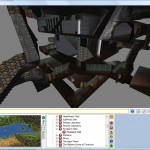 |
Privateer’s Hold
This first image shows the basic layout of Daggerfall Scout. The user interface can be docked to the top or bottom of the window, or collapsed down to a small status bar with just the basics.
In the bottom-left is a map of the Illiac Bay, allowing you to choose a region to explore. Just to the right of that is a hierarchy of locations that can be filtered by type. If you’ve ever used Daggerfall Cartographer, you will be familiar with this concept. The difference here is that Daggerfall Scout supports all world locations, including dungeons and interiors.
The blue square on the right will eventually be used for several purposes, such as displaying a graphical minimap and controlling properties.
Along the top of the user interface is a status bar and commonly used buttons. When collapsed, this is the only visible portion of the user interface.
Currently loaded is the centre portion of Privateer’s Hold. |
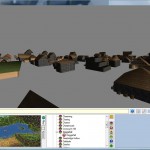 |
Daggerfall City
You can see from this screenshot I’m only part-way through porting my world builders from Absinthe (engine written for The Daggerfall Project) to Irrlicht (a simple and easy to use open-source engine). The ground plane and the sky are missing! I will slowly fill in the blanks as development progresses.
If you open the thumbnail and look at the location view, you will notice there are two Daggerfalls in the tree view. The parent Daggerfall is the city. The child Daggerfall is the dungeon contained inside Castle Daggerfall. I am working on a free-roaming mode allowing you to enter dungeons and buildings through the front door, just like you would in the game. For now, all dungeons follow this format, allowing you to swap between world cells and dungeon cells with a single mouse click. |
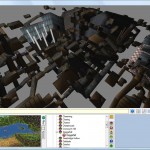 |
Castle Daggerfall
This screenshot is an overhead view of the twisting labyrinth inside Castle Daggerfall. If you look to the right of frame, you can just see the Treasury. How many hours have we all spent search for the Totem in that twisting mess?
Another limitation of the current build is lighting. Ultimately, I want to render Daggerfall’s light sources as they appear in game – recapturing the atmosphere of those dark places.
While exploring you will be able to toggle gravity and collision, allowing you fly through the map with ease or explore on foot. |
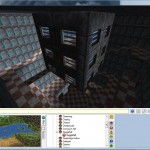 |
Daggerfall Treasury
This is a close-up of the Treasury inside Castle Daggerfall. Using the first-person flying camera with no collision, I have positioned myself high in the room.
One of the long-term features of Daggerfall Scout is to allow world interaction. There is a complex puzzle in this room to find your way to the Totem. I would like to enable the explorer to action levers, teleporters, doors, etc. |
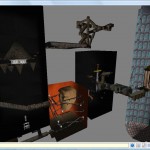 |
Mantellan Crux
This famous dungeon marks the end of the main quest in Daggerfall. Each part of the dungeon is a self-contained puzzle room where you are beset by foes. Only the most powerful characters could find their way past these challenges.
This screenshot also shows the user interface collapsed down to just the status panel. |
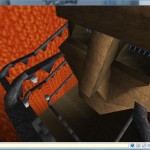 |
Blind God
A close-up of the fire room in the Mantellan Crux, looking down on the Blind God. |
I hope to release the first version of Daggerfall Scout in a few months time. The plan is to release a fun world explorer and continue to add features in subsequent builds.





